Researchers are making significant strides in reducing embedded carbon in concrete, but public policies have been slow to adopt this more sustainable option, according to Matthew P. Adams, an associate professor and co-director of the Materials and Structures Laboratory at New Jersey Institute of Technology.
Knowledge and technical data about greener concrete must be more widely dispersed to government decision-makers and industry to foster increased adoption of sustainable concrete, Adams says. “Building codes at the local, state, and national level are slow to permit the use of new technologies in building materials, despite extensive strength and durability testing,” he says.
“Many public agencies and engineering companies are afraid to embrace new methods without strong proof of their long-term durability and performance in real-world applications,” Adams says. But, making “accessible, easily digestible information” about the performance of greener concrete options, how best to specify these materials, and what materials are locally available to policymakers does have an impact, he notes.
For example, officials in the Village of Hastings-on-Hudson, N.Y., committed to promoting the use of low-carbon concrete materials in building and infrastructure projects. They backed up new policy with education and support to the construction industry about low-embodied carbon concrete. These efforts led to multiple local projects built with more environmentally friendly concrete including sidewalks and a new elementary school.
The town’s success led to other New York communities passing similar resolutions. The New York State Legislature subsequently passed the Low Embodied Carbon Concrete Leadership Act to advance the use of greener concrete statewide. Such public policy actions will be needed to take full advantage of the promise of more sustainable concrete materials devised in labs, Adams says.
Related Stories
Building Enclosure Systems | Oct 30, 2024
Winners of Building Envelope Innovation Prize focus on secondary glazing
The U.S. Department of Energy (DOE) recently announced the winners of the first phase of the Building Envelope Innovation Prize. The prize targets high-performance, cost-effective secondary glazing systems to improve efficiency of commercial windows.
M/E/P Systems | Oct 30, 2024
After residential success, DOE will test heat pumps for cold climates in commercial sector
All eight manufacturers in the U.S. Department of Energy’s Residential Cold Climate Heat Pump Challenge completed rigorous product field testing to demonstrate energy efficiency and improved performance in cold weather.
Resiliency | Oct 29, 2024
Climate change degrades buildings slowly but steadily
While natural disasters such as hurricanes and wildfires can destroy buildings in minutes, other factors exacerbated by climate change degrade buildings more slowly but still cause costly damage.
Contractors | Oct 25, 2024
Construction industry CEOs kick off effort to prevent suicide among workers
A new construction industry CEO Advisory Council dedicated to addressing the issue of suicide in the construction industry recently took shape. The council will guide an industry-wide effort to develop solutions targeting the high rate of suicide among construction workers.
Codes and Standards | Oct 17, 2024
Austin, Texas, adopts AI-driven building permit software
After a successful pilot program, Austin has adopted AI-driven building permit software to speed up the building permitting process.
Resiliency | Oct 17, 2024
U.S. is reducing floodplain development in most areas
The perception that the U.S. has not been able to curb development in flood-prone areas is mostly inaccurate, according to new research from climate adaptation experts. A national survey of floodplain development between 2001 and 2019 found that fewer structures were built in floodplains than might be expected if cities were building at random.
Seismic Design | Oct 17, 2024
Calif. governor signs limited extension to hospital seismic retrofit mandate
Some California hospitals will have three additional years to comply with the state’s seismic retrofit mandate, after Gov. Gavin Newsom signed a bill extending the 2030 deadline.
Codes and Standards | Oct 16, 2024
North Carolina’s code policies likely worsened damage caused by Hurricane Helene
The North Carolina Legislature’s rejection of building code updates likely worsened the damage caused by Hurricane Helene, code experts say. Over the past 15 years, lawmakers rejected limits on construction on steep slopes, which might have reduced the number of homes destroyed by landslides.
MFPRO+ News | Oct 16, 2024
One-third of young adults say hurricanes like Helene and Milton will impact where they choose to live
Nearly one-third of U.S. residents between 18 and 34 years old say they are reconsidering where they want to move after seeing the damage wrought by Hurricane Helene, according to a Redfin report. About 15% of those over age 35 echoed their younger cohort’s sentiment.
Construction Costs | Oct 16, 2024
Construction Crane Index: Most major markets’ crane counts increase or hold steady in third quarter
Rider Levett Bucknall’s (RLB’s) latest Crane Index and Quarterly Cost Report shows continued decreasing cost inflation and crane counts increasing or holding steady in 10 of the 14 major markets it surveyed. The national average increase in construction costs was 1.07%, the lowest it’s been in the last three years.

















